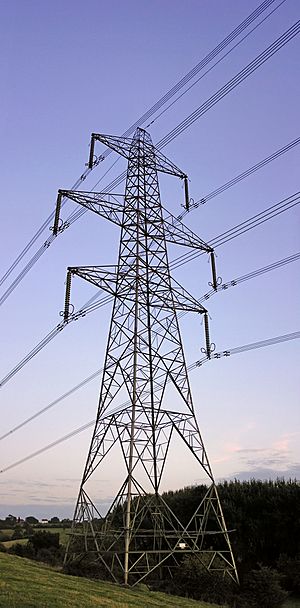Pylon facts for kids
A pylon (also known as a transmission tower) is a tall structure, usually made of steel, that holds up the wires carrying electricity. These wires, called overhead electricity conductors, move electric power from where it's made (like a power plant) to where it's used (like cities and towns). Pylons are a very important part of how we get electricity every day.
Contents
Pylons: Towers of Power
Pylons are like giant metal trees that support the invisible highways of electricity. They are designed to keep the power lines high above the ground. This prevents people and animals from touching them, which is very dangerous. Without pylons, it would be much harder to send electricity over long distances.
What is a Pylon?
A pylon is a strong, tall structure, most often built from steel. It looks like a giant metal frame or a lattice. The main job of a pylon is to hold up the thick cables that carry electricity. These cables are called transmission lines. Pylons keep these lines separated and away from the ground.
Why Do We Need Pylons?
Electricity is usually made far away from where people live. Power plants might be near a river or a coal mine. Pylons help move this electricity from the power plant to your home. They are essential for a reliable electricity supply. Imagine trying to power a whole city without them!
How Electricity Travels
First, electricity is made at a power station. Then, it goes through a special building called a substation. Here, the electricity's voltage (its "push") is made much higher. This high voltage electricity travels along the thick wires held up by pylons. It can travel hundreds of miles this way. When the electricity gets closer to towns, it goes to another substation. Here, the voltage is lowered so it's safe for homes and businesses.
How Are Pylons Built?
Building a pylon is a big and careful job. It involves many steps to make sure the tower is strong and safe. Each pylon must be able to stand up to strong winds, ice, and the heavy weight of the power lines.
Materials Used
Most pylons are made from strong steel. Steel is chosen because it is very durable and can handle a lot of stress. The steel parts are often coated to protect them from rust and weather. Sometimes, concrete is used for the base of the pylon to anchor it firmly into the ground.
Building the Towers
First, engineers plan where each pylon will go. They make sure the ground is stable enough. Then, a strong concrete foundation is built. This foundation acts like the pylon's feet, keeping it steady. Next, the steel pieces are brought to the site. Workers use cranes to lift and bolt the pieces together, building the tower section by section. Finally, the power lines are carefully strung between the pylons.
Different Kinds of Pylons
Not all pylons look the same. Their design depends on how much electricity they need to carry and the type of land they are built on. Some pylons are very tall, while others are shorter.
Suspension Pylons
These are the most common type. They hold the power lines in a straight line. The wires hang down from the pylon, like clothes on a clothesline.
Tension Pylons
These pylons are stronger and are used where the power lines change direction. They are also used at the beginning and end of a power line section. They have to withstand more pulling force from the wires.
Other Designs
Some pylons have unique shapes, like "T-pylons" which are newer and designed to be less noticeable. There are also very tall pylons used to cross wide rivers or valleys.
Staying Safe Around Pylons
Pylons and power lines carry very high voltage electricity. It is extremely dangerous to get too close to them. Always remember to stay a safe distance away.
Important Safety Rules
- Never climb a pylon.
- Never touch a power line, even if it looks like it's on the ground.
- Do not fly kites, drones, or balloons near power lines.
- Do not build fires or play games directly under power lines.
- If you see a fallen power line, stay far away and tell an adult immediately. They should call the emergency services.
Pylons and the Environment
Pylons are a necessary part of our modern world, but they can affect the environment. They take up space and can be seen from far away. Engineers try to plan routes that avoid sensitive areas like national parks or important wildlife habitats. Sometimes, birds can perch on pylons, and special designs are used to keep them safe.
A Brief History of Pylons
The first electricity transmission lines were built in the late 1800s. As the demand for electricity grew, engineers needed ways to send power over longer distances. This led to the development of the first steel lattice towers, which are the ancestors of today's pylons. Over the years, pylon designs have improved, becoming more efficient and stronger. They continue to be a vital part of our energy system.


